Andrew Skurka's Blog, page 15
September 8, 2020
What’s for lunch? 40+ favorite ideas
As a hard-charging thru-hiker — when I would hike sunrise-to-sunset, take very few breaks, and cover 30 to 40 miles day after day — food was simply fuel. I carried items that were calorie dense, required minimal or no field preparation, and could be eaten on the go. So I ate a lot of bars back then — energy bars, candy bars, granola bars, cereal bars, and Pemmican bars. And to keep my energy level sustained, I ate precisely on two- to 2.5-hour cycles.
With many more of my backpacking days now in a guided trip setting, my approach has evolved. Our trips are more about smiles over miles, and both clients and guides appreciate a dedicated “lunch,” when there’s enough time to prepare a meal, rest, and maybe tend to things like laundry and bidets.
I’ve found two personal lunch favorites:
Ham sandwich on a bun with cream cheese, for the first day or two; and,Avocado with a salty and crunch carbohydrate, like Pringles or Fritos, for later in the trip when the safety of deli ham is more questionable.
But there are many other options, and I recently asked on Instagram for additional favorites. Here are the responses:
View this post on InstagramA post shared by Andrew Skurka (@andrewskurka) on Sep 4, 2020 at 8:55am PDT
What’s your backpacking lunch? Leave a suggestion below.
The post What’s for lunch? 40+ favorite ideas appeared first on Andrew Skurka.
August 14, 2020
A women’s guide to backcountry hygiene || Menstruation, pee & poop, UTI’s, skin care
Has the fear of managing your bodily functions kept you from hitting the trail for a weekend of fun in the outdoors? Does the thought of dealing with your period in the backcountry prevent you from backpacking for several days in a row?
Don’t fret! You are not alone in having hesitations about managing feminine hygiene in the backcountry. With the right tools and practice, you can still have a clean and enjoyable time in the woods, even when it’s time to go or when it’s your time of the month.
In this post I’m going to cover it all: Pooping, peeing, and period management, plus a few extra tips and tricks to keep all of your lady parts happy while you’re frolicking in nature. Some of this may be repeat information for some folks, but proper backcountry bathroom technique is important to refresh upon, so bear with me.
Men: This if for you, too!
Odds are, at some point, you will be on a trip or hiking with a woman who is squeamish about these topics. It’s a natural thing, and all genders should be aware of the best practices while in the wilderness.
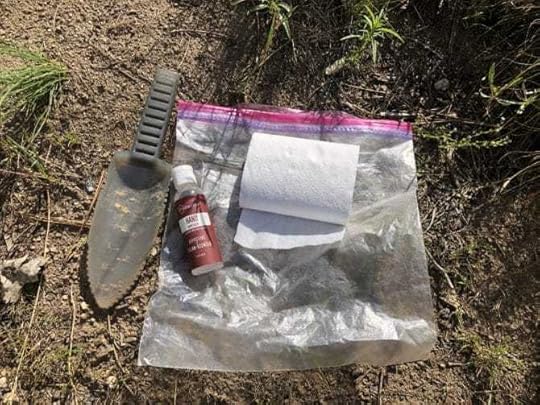
Poop
Unfortunately, I recently returned from the Sawtooth Wilderness and was appalled by the frequency of unburied human poop. Simply doing your business behind a tree and putting a rock over is unacceptable!
Considerations & goals
But, before we get into the ins and outs of backcountry pooping, let’s talk about why we should care about properly disposing of human waste in the first place: Water contamination. After all, we get our water from lakes, streams, and snowmelt, so what ends up downstream could make us sick.
There are some valid concerns about wild animals getting into human waste too, since our diets can be packed full of preservatives, artificial ingredients, medications, etc that are not natural to the ecosystem. When wild animals ingest our waste, it may harm them and their offspring. Also, if you hike with a dog and they are prone to eating poop, there is nothing nastier than your pup offering you some kisses after chowing down on someone else’s sh*t.
As a general rule, you shouldn’t leave anything behind besides your poop, pee, or menstrual blood. Follow Leave No Trace standards and dig a six- to eight-inch-deep cathole at least 200 feet from a water source. Poop directly into the hole, dump all bodily fluids, and any water used to clean your period supplies inside it, and fill it back in tightly with dirt. Easy!
Supplies
Before going doo-doo though, you’ve got to put together a proper poo kit. Your kit should contain the following:
A small shovel for digging your cathole Clean toilet paper (remove the cardboard roll for easier storing), and wet wipes if desired A small ziplock for packing out used toilet paper, tampons, wet wipes, etc. I like these odor-proof reusable Opsak bags.Hand sanitizer
When you are in an area where digging a hole in the ground isn’t possible (such as on snow, a glacier, or super rocky areas), you have to pack out your poo with you because (spoiler alert!), it does not magically disappear when you bury it in snow. Wag bags are a simple solution to pooping in these areas. These are puncture-resistant bags that you poop in which contain a “magic powder” to cover any smells within the bag.
Menstruation
Do you have fears that a bear will pick up your scent and track you while you are on your period? An age-old myth was born in August 1967 when two separate women were killed by grizzly bears in Glacier National Park – one of the women was on her period.
As a result, the NPS and the United States Forest Service put out a brochure on outdoor safety and advised women to “Stay out of bear-country during their menstrual period.” This set the stage for years of rumors that period blood attracts bears and other wildlife. Time to put that myth to rest! Studies have found it pretty inconclusive that bears are attracted to menstrual blood.
However, some women also choose to avoid the outdoors while they are on their period because they just don’t want to deal with the management of tampons/pads and navigating how to stay clean. These feelings are completely understandable, but nowadays there are lots of ways to manage your period that can make your backcountry experience less stressful.
Options
Start with these simple steps so that you won’t have to think twice about heading into the backcountry during any time of the month:
Practice at home: Whether you’re going to use tampons, pads, menstrual cups, or period underwear, be sure that you are familiar with it before you leave the house. Menstrual cups take practice to insert, and if you’re giving period underwear a try, you want to make sure you can hike comfortably in them.Organize your supplies: You should have a clean plastic bag, and a plastic waste bag. Your kit should include TP or wipes and hand sanitizer. You can wrap your waste bag in duct tape to conceal it. If you’re using tampons or pads, you can put a fragrant tea bag in it to help cover any odor.
Personally speaking, I haven’t had a period in almost 6 years thanks to the birth control that I take, so I reached out to my friend Theresa Silveyra who is an avid backpacker, trail runner, and mountaineer for her input:
“My go-to item for managing my period in the backcountry—as well as in daily life!—is a menstrual cup. I can wear it for up to 12 hours on light to moderate flow days while out on the trail, and I don’t need to worry about creating additional waste like I would if I were using tampons. Similar to pooping in the backcountry, I dig a Leave No Trace standard cathole when it comes time to empty the cup. Keeping the cup clean is important. I always sanitize my hands before removing it and inserting it. I also make sure to clean the cup itself—with clean water or with specific menstrual cup cleaning wipes that I then pack out—before re-inserting it. I will say that the removing/emptying/cleaning/re-inserting process is a little more tedious than the “fast and convenient” feel of dealing with tampons, but this process only needs to be done about twice a day and you don’t have to worry about packing out and storing a bunch of used tampons in your pack for days on end!”

Chafing
“Swamp Ass”, “Booty Juice”, “Monkey Butt”. Whatever you want to call it, everyone experiences butt sweat, and for some, it can be uncomfortable and cause chafing. On top of that, some of us ladies also experience the dreaded underboob sweat. Many people (myself included) are sweatier than others and even though excessive sweating is mostly harmless, it can be embarrassing.
Some ways to prevent it are:
Clothing: I highly recommend investing in quality, moisture-wicking clothing that will dry quickly. Cotton should be avoided, especially when it comes to your underwear. Topical treatments: There are several balms and powders, but my favorite for pretty much anywhere on the body is bodyglide. Keep yourself fresh: If you feel some unwanted chafing on the horizon, give yourself a quick wipe down with a wet hygiene wipe.
Urinary tract infections
Also, women are more prone than men to have a pee or sweat related hygiene issue on outdoor trips, so you should plan on bringing extra pairs of clean underwear to avoid yeast infections or UTIs.
Peeing
Now, when it comes to peeing, some prefer to squat while others prefer to stand using a pee funnel. Just like with a menstrual cup, be sure to practice using your pee funnel at home first in the shower, and always be sure to rinse it at least once a day while you’re out in the backcountry.
Whether you squat or stand, a pee rag can be helpful instead of drip-drying. Kula Cloth makes a reusable antimicrobial pee cloth that has quickly developed a cult following. I also recently reviewed some awesome pants called SheFly. They are designed with a zipper that starts in the front and unzips all the way around to the back, allowing women to simply unzip, squat, and pull their underwear to the side to pee. You can read my full review of SheFly pants here.
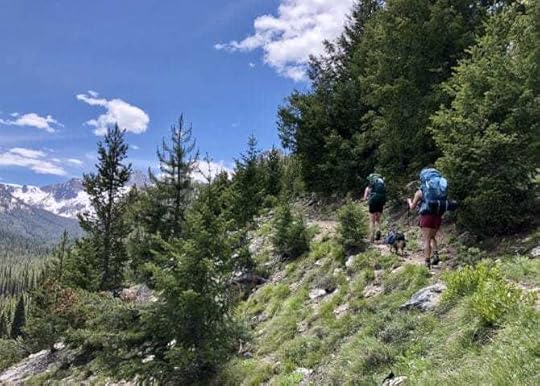
Skin care
I’ll wrap this up with a push for a good daily facial moisturizer with sunscreen because outdoor elements can be harsh when you’re in the backcountry. Your skin will take a beating and likely get very dry while backpacking, especially at altitude.
My favorite facial moisturizer with sunscreen (that is also sweatproof) is the Supergoop Unseen Sunscreen. Wipe your face down every evening before bed with a wet wipe, and then apply a fresh layer of moisturizer with SPF every morning after you’ve cleaned your hands.
With the right preparation and care of your body you’ll be sure to have an awesome time exploring Mother Nature!
Your turn: Leave a comment
What questions do you have about female hygiene in the backcountry?How do your own best practices differ from those suggested in the article?
The post A women’s guide to backcountry hygiene || Menstruation, pee & poop, UTI’s, skin care appeared first on Andrew Skurka.
August 11, 2020
Backpacking shelters for the BIG & tall, and those who sprawwwl
Backpacking tents and tarps are generally not designed for the big & tall and for those who love to sprawl. Many designs are cramped and claustrophobic for these users, which may hinder a night of quality sleep and lead to a soaking-wet sleeping bag from condensation-covered walls.
If this sounds like your nighttime experience, this article is for you. It will help you to find a new shelter that is sized properly for a backpacker with your dimensions and habits.
Very limited information is available about shelters for larger people. I’ll address this problem not with another list-icle (i.e. “10 Best Tents for Tall Backpackers in 2020”) but with a revolutionary new system for measuring the usable area of tents and fixed-shape tarps. Then, using this system I will offer standards for comfort and I will examine several popular models.
Key takeaways
This is a thoughtful post about an important topic, and the word count reflects that. Here are the main takeaways if you’re short on time:
There are very few tent options for hikers who are taller than 6’4”. If this is you:
The Lightheart Gear SoLong 6 could be your best tent option, but;Flat tarps with a bivy are infinitely customizable; and,Companies like Mountain Laurel Designs make a wide variety of pyramid tarps that are large enough to fit a circus elephant, and a tarp with a large inner net can be just as luxurious as a traditional tent.
There are many more options for people from 5’11” to 6’4”, and many traditional tents may even fit you depending on your sleeping habits. If you need more room then you might consider larger models like:
Lightheart Gear Firefly,SMD Skyscape Trekker, or Various designs from Tarptent that include struts and arched poles.
Proposal: A new standard for measuring tents
For a moment, imagine buying new pants without a waist or inseam (leg length) measurement. Instead, the pants are measured by their total length and by the square footage of the fabric.
With enough pants-buying experience, you may learn that you need pants that are three feet long and that are made with five square feet of fabric. But doesn’t that sound insane? Those measurements aren’t helpful, because they don’t really give you a sense of how they will fit YOU.
The same thing happens when buying a tent.
Today, tents are primarily measured and compared by their:
Peak height,Floor length and width, andFloor square area.
But just like the contrived pants measurements, these numbers are only loosely correlated with usable interior volume, which is the metric about which we really should care.
Three alternate measurements would be much more informative and revealing:
Sleeping length: The length across the sleeping area of the tent, measured one foot off the ground, which will be comfortable for a sleeper using an inflatable sleeping pad and a sleeping bag.Sleeping area: The total usable sleeping area created by the sleeping length and the width at the head and foot, all measured one foot off the ground. This forms a long trapezoid.Headroom: The available headroom while sitting, measured three feet off the ground, in a diamond shape.
Results
For measurements of popular tents, go HERE;For measurements of popular mids tarps, go HERE.
If a shelter you’d like to buy is not on one of these spreadsheets, let your favorite tent company know about this article. I’d be happy to measure their shelters, or they can adopt my new standard, which would save me a lot of work, and give them a leg up on this new system.
General case studies
Let’s look at some simplified examples to see how different tent shapes affect sleeping length and headroom. The diagram below shows a 6-foot tall person sitting up and laying down in a sleeping bag on a sleeping pad.
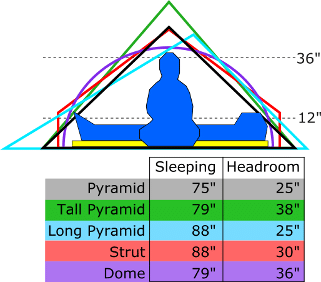
From this we can adopt some general rules:
Increasing the height primarily affects the headroom and has a smaller effect on the sleeping area.Increasing the length primarily affects the sleeping area and has a smaller effect on the headroom. Note that the long pyramid has a slightly lower peak than the pyramid but has the same headroom.Adding struts (or pitchloc’s) has the same effect as increasing the length while reducing the footprint.Adding a domed tent pole increases both the sleeping area and headroom and also reduces the footprint.
How much room do you need?
Follow this simple rule of thumb: Your sleeping area should equal your height plus five inches, to make room for your sleeping bag insulation and angled feet.
Several factors can affect this rule of thumb though:
If you sleep on a thick or a thin pad. Add 2-4” for a thick pad (4”) or subtract 2-4” if you use a thin pad (1”). Make larger adjustments for a tent with angled walls and less for a tent with steep walls.If you sleep in a single wall tent and want to avoid condensation. Add 2” for each single wall by your feet or head. Two at the most.If you sleep in a low-tension (droopy) inner net (does not apply to traditional double-wall tents where the inner net is high-tension). Subtract 3” since the netting will not compress your sleep insulation.If you are claustrophobic or toss and turn. Adjust accordingly!
NOTE: You can get away with a shorter sleeping length than this rule of thumb dictates. It is only a starting point that should work for most people.
Keep in mind that headroom is also largely a personal preference. Also, torso size can obviously vary between people of the same height. If you have a long torso then you will need more headroom than a person of a similar height but with a shorter torso. If you like to spend time in your tent after hiking, or if you plan to hike for several weeks or months, then you may also prefer having more headroom because it’s just more livable.
Real case studies
Now let’s look at measurements for a few tents pitched in the real world using this system. Hopefully, you’ve got some idea of where you fall due to personal experience with one or more of these models. Obviously, there is some variability between pitches of the same tent, but I estimate that the measurements are pretty accurate, more so for poled tents than tarps or mid-style shelters.
For a higher resolution diagrams, go here.
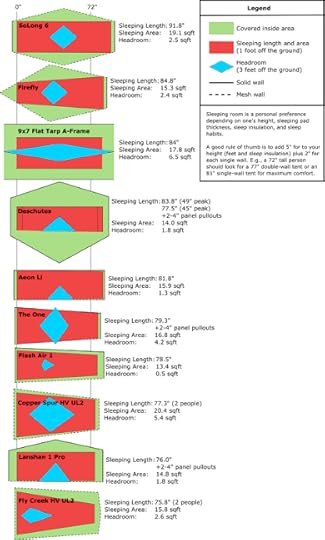

Summary and advice
Understand your personal needs. Look for a tent that accommodates your needs. Realize that your needs are unique to YOU.
AGAIN: Don’t let some random internet stranger convince you that you should feel comfortable in a tent that doesn’t fit you.
PERFECT EXAMPLE: My friend (and guinea pig for this article) is 6’7”. He sleeps in a Fly Creek UL2, even though he is way too big for it according to my new standard of measurement, but he has accepted the tradeoffs and is happy because it meets his needs. Meanwhile, I’m about 6’ and find that tent unbearable. Our needs are different, so it is not productive to argue about what size person fits in what size tent. It’s apples to oranges.
However, using my system we can objectively agree that a Copper Spur is roomier than a Fly Creek. Therefore you should look at the objective measurements in this article and determine what meets your specific needs.
Keep in mind this project is just getting started, but my goal is to set a new industry standard and I need your help! Let your favorite tent company know that there is a better way to help their customers choose a shelter that will reduce costly returns, increase profitability, and consumer satisfaction by referring them to this article. Everybody wins!
Thanks for reading, and happy trails.
Questions or thoughts? Leave a comment.
The post Backpacking shelters for the BIG & tall, and those who sprawwwl appeared first on Andrew Skurka.
August 10, 2020
Fueling & nutrition for the female trail athlete
My first summit hike of Mt. St. Helens took over 16 hours round-trip, and I hit the wall a little more than halfway up. From there, every step to the summit was a struggle, and it took days to recover after the climb. I didn’t know it then, but a flawed nutritional strategy had set the stage for this experience!
Fast forward to today, with twenty additional years of experience and countless trail miles under my belt, and I know a few more things about fueling the female athlete. I’ve learned through trial and error, hard lessons, and great mentors, too. I’m thrilled to share these tips with you now!
DISCLAIMER: I’m not a doctor, and everyone is different. There is no one-size-fits-all approach, and the needs of your body may be very different from mine. I recommended using these tips as a starting point. Adjust them all as needed to your own personal goals and metabolic profile. This will involve some experimentation on your part, but the process is well worth it. Eventually, it will help you to power you through long days, and ultimately reward you with more enjoyment outdoors.

Goal #1: Avoid The Bonk
“The bonk” is commonly experienced as a sudden drop in energy, nausea, dizziness, and, in extreme cases, hallucinations.
Avoiding it became critically important to me when I started tackling longer hikes, and unfortunately, I’ve experienced it several times. Especially on ambitious, multi-day trips with lots of elevation gain.
It happens when the energy needs of an endurance athlete (sometimes greater than 400 calories an hour) exceed the amount of glucose available in the body. The depletion of glycogen (a fast-burning simple carbohydrate easily accessed by the body) can quickly create this caloric deficit, which is why endurance athletes are most vulnerable to it.
As you can imagine, the physiological needs of endurance sports, combined with the common societal pressures for women to avoid fat and worry about weight gain, can create a recipe for failure for female athletes.

Fueling Fundamentals: Laying The Groundwork
I focus on three fundamental rules to keep me fueled on the trail:
Eat Enough: 2,400 – 3,000 Calories /per DayEat Often: Minimum 200 – 300 Calories /per Hour While MovingEat Well: Focus on Quality Food Sources
Of course, these rules are more easily followed with intentional pre-trip planning and on-trail time management strategies. Here are three strategies that work for me:
Break Often: Every 1-2 Hours, take a quick break and have a 200 – 300 Calorie Snack Keep Food Accessible: Keep small Snacks in Hipbelt Pockets for Snacking On-the-GoDon’t Eat Boring Food: Rotate Salty / Chewy / Crunchy Snacks that you actually want to eat!
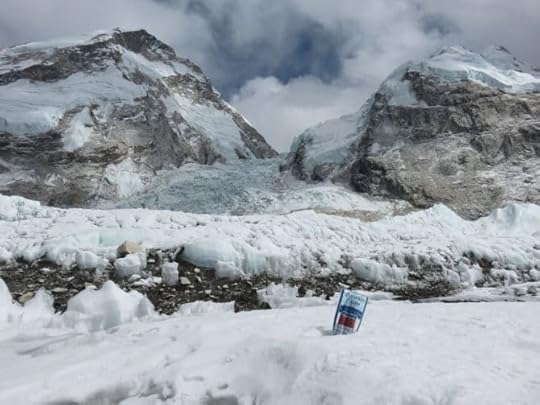
Good News Ladies: We Are Natural Endurance Athletes!
Yes, we have yet ANOTHER secret superpower! Recent studies point to the ability of the female endurance athlete (operating below 70% max effort over long periods of time) to more efficiently burn fat as fuel. Score! This is great news for women athletes, as the human body has a greater ability to store fat rather than glucose as available fuel.
The secret to my success is a potent combination of the fundamentals noted earlier and this additional fat-burning superpower. I’ve found that I perform best on an outdoor nutrition plan based on the following caloric breakdown:
50% Fat20% Protein30% Carbohydrates
Yes, this model IS lower in carbohydrates than many long-distance hiking nutrition plans you may have seen before, and your mileage may vary. However, I have found that a higher fat nutrition plan is not only more weight-efficient (gram-counters rejoice!), but less prone to generate energy crashes, and subjectively tastier than higher carbohydrate models too. IMPORTANT NOTE: This strategy relies on eating often (at least every 1-2 hours) in order to allow enough time to convert fat calories into usable fuel. Remember to avoid the bonk!
What’s On My Grocery List?
Basically, I start with standard meal templates and then look for ways to add more quality fats, drop out low-quality carbohydrates, or both.
Example: Dropping some of the oats in favor of chia seeds in breakfast recipes, adding freeze-dried cheese to noodle or rice-based dinner recipes, or adding coconut oil to commercially prepared backpacking meals.
I also highly recommend whole foods over processed food sources. You will never find a store-bought carbohydrate-heavy bar in my pack. What you will find are high-fat natural food sources like:
Nuts & Nut ButtersAvocadosHard CheesesSalamiCoconut Oil Packets
These are rounded out with enough supporting ‘guest stars’ to provide both convenient and tasty transport as well as nutritional complements. They often include:
Tortillas or Durable BreadsHigh-Fat Crackers or ChipsDried Fruit and Vegetables
What is ‘Fat Adaptation’?
Your performance as a female endurance athlete may also be enhanced by overall lifestyle changes too. Alterations to your day-to-day nutritional approach may greatly influence your ability to efficiently perform over long distances and grueling days, so it’s worth considering.
This process of ‘fat adaptation’, recently popularized by the keto diet, focuses on enhancing the ability to burn fat as a primary fuel source. I recommend researching Fat Adaptation, training in a fasted state, and the practices recommended by the ‘Training for the New Alpinism’ and ‘Uphill Athlete’ team for further reading of this topic.

Wrapping it all up: Food is Fuel
As you can imagine, I now plan the food that goes into my pack with the same level of scrutiny and intention as anything else. Food is the fuel that supports our bodies over countless miles, carries us to breathtaking vistas, and supports our recovery process, so it should never be an afterthought.
Of course, food can be delicious and fun too (I do love me some fun-shaped crackers!) but it is so much more than that. A solid nutrition plan can be the difference between long and wonderful days in nature, and endless suffer-fests. Remember: You’re in charge of choosing the fuel that goes into your own personal adventure machine.
Choose wisely!
Your turn. Leave a comment:
What food items sustain you best on the trail?Do you have memorable food stories or lessons? Please share.What questions do you have about fueling for the female athlete?
The post Fueling & nutrition for the female trail athlete appeared first on Andrew Skurka.
August 3, 2020
Preview: SPOT Gen4 || Updated 1-way messenger
The SPOT Gen4 was officially released today. This fourth-generation device remains a one-way messenger, and both its hardware and software has been updated from its predecessor, the Gen3 (my review), which was released more than six years ago.
Functionality
Like the Gen3, the Gen4 can send outgoing messages only, limited to:
SOS,Help,Check in/OKAY, and,Custom, which must be pre-programmed in the user’s online account.
The Gen4 is also capable of location tracking, in frequencies of 5, 10, 30, and 60 minutes (all included with the basic subscription), plus a 2.5-minute interval with a service upgrade.
Changes
A few improvements have been made to both the Gen4 hardware and software.
The device now has IP68 rating for dust and water. SPOT also describes it as having a “sleek new look, with improved grip and secure design features that snap in place.” I have not handled the device in-person so I can’t verify this; I don’t recall the Gen3 unit feeling flimsy, so their starting point was already high.
Location tracking can be motion-activated (instead of just running continuously), thus conserving battery life. And no longer must the tracking be reset after 24 hours, which was an annoying quirk.
Specs and service
5 oz with lithium batteries3.48” x 2.66” x .93”$150 MSRPService plans start at $12 per month (with annual contract) or at $15 per month (on a month-to-month plan)
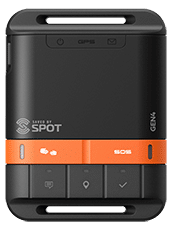
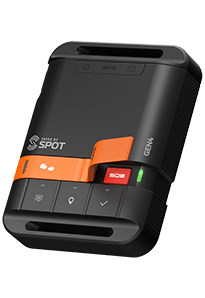
Assessment
Without seeing this device in-person and using it in the field, my evaluation should be taken with a grain of salt. But don’t dismiss it — I’ve been using satellite messengers since 2008 and I’ve stayed atop the category.
I appreciate the improvements in the Gen4, but overall I feel like this device misses the mark. SPOT’s one-way messaging was groundbreaking in 2008 when the first-generation device was unveiled, and it was still acceptably high-tech in 2014 when the Gen3 was released.
But in 2020, I struggle with offering a compelling reason to buy it. I think most consumers would be happier with a:
Personal locator beacon (PLB) like the ACR Electronics rescueME ($290), which offers SOS messaging only (no “I’m okay” check-ins) but which will be more economical in the long-term; or a,Two-way satellite messenger like the Garmin inReach Mini (my preview), ZOLEO (my review), or Somewhere Global Hotspot (review forthcoming), which are a bit more expensive to own and operate but which are capable of two-way messaging, which is vastly more helpful and useful for both those in the field and at home.
Is there any case for the Gen4 still? Yes, I can think of two. First, consumers who want the option to check-in regularly but who don’t need or want those back home to check in with them. Second, consumers who want the option to check-in regularly but who can’t afford to the marginal extra cost for two-way messaging.
These audiences seem small to me, and I’m waiting for SPOT to develop a Gen4-sized unit that offers two-way messaging like its SPOT X device (my review).
Leave a comment
What questions do you have about the Gen4?What is your initial take on it?
Disclosure. I strive to offer field-tested and trustworthy information, insights, and advice. I have no financial affiliations with or interests in any brands or products, and I do not publish sponsored content
This website is supported by affiliate marketing, whereby for referral traffic I receive a small commission from select vendors like Amazon or REI, at no cost to the reader.
The post Preview: SPOT Gen4 || Updated 1-way messenger appeared first on Andrew Skurka.
FKT attempt: Pfiffner Traverse
Starting at 4 AM tomorrow morning I will attempt an unsupported fastest known time (FKT) on the Pfiffner Traverse, a 76-mile high route through Rocky Mountain National Park and the Indian Peaks and James Peak Wilderness Areas. This project has been on my radar for years, and the pieces have finally aligned to make a go of it.
The route
In Boulder there is disagreement over exactly what constitutes “the” Pfiffner Traverse. All variations use Milner Pass and Berthoud Pass as the termini, but beyond this parameter the interpretations range from a purist’s atop-the-Divide scramble to a more convenient mostly-trail ultra marathon course.
I’ll be following the Primary Route, which I spent several years developing and which I’ve hiked and run in its entirety and in segments (with some itineraries making this list of 8 very adventurous loops in the Colorado Rockies). The Primary Route is the Goldilooks option: it generally stays high and close to the Divide, but it’s willing to drop lower to avoid technical terrain, access better country, or provide a more natural flow. Based on the number of backpackers and trail runners who know of the Pfiffner Traverse only through my guidebook, I expect this route to become “the” route, if it’s not already.
 Steve at Paiute Lake in late-June
Steve at Paiute Lake in late-JuneGoal time
The only previous FKT attempt was in 2018 by Sunny Stroeer, who completed the Primary Route in 2 days 6 hours and 41 minutes. It’s a strong time in the women’s unsupported category.
No known male has attempted to set a time on the route, so I’m attempting more of an OKT (“original known time”) than a FKT. I’m hoping to finish at least in 48 hours (B goal) but hopefully more like 36 hours (A goal). My thinking:
My time will be most strongly correlated with the route’s vertical gain (28,500 feet), not horizontal distance (76 miles). For very mountainous courses, routes, and trails, this is predictably the case.
My best comparison is UTMB, which had 33,300 vertical feet of gain and which in 2017 I finished in 24:44, meaning that every minute I climbed 22.4 vertical feet and descended 22.4 vertical feet, on average.
My fitness is not as high now, so I’m thinking that 20 vertical feet of gain per minute (a 10% reduction) is a better assumption when I’m on-trail, and that 13.3 vertical feet of gain per minute (two-thirds of my on-trail vertical speed) is a realistic assumption when I’m off-trail.
Using these assumptions, I get 28.6 hours.
Adjust for the higher altitude (+1 hour, or 47 seconds per mile), heavier pack (+1 hour), and longer duration (+1 hour), and then add cushion for weather delays (+ 2 hours) and sleep (+2 hours).
This gets me to 35.5 hours.
Gear
I’ll post my gear list in a separate post. When I leave the trailhead, my pack will weigh 9-10 pounds total, which has a surprising influence on pace and climbing ability.
The heaviest items:
Food (3 pounds)
Packed clothing (2 lbs)
Water (1.5 pounds when full),
My pack (1 lb), and,
Trekking poles (10 oz when not in use)
Recently I’ve gone for a few runs with my fully loaded pack, just so the weight and organization is not foreign to me on Tuesday morning.

Training
Like many athletes, my 2020 racing plan was blown to bits by the virus. Last November I started training for the Colorado Marathon, which would have been my entry into the 2021 Boston Marathon, and I was on track to finish in the low-2:30’s. That race was cancelled, and so too were all my backup options, including both local (Colfax, REVEL) and distant (Utah Valley, Deadwood Mickelson).
A strained calf in June knocked me out for a few weeks, but otherwise my training has been consistent (60 miles per week, two workouts per week plus a long run) and my fitness has stayed high. When I threw down a 130-mile week with 24k vertical gain last month in Yosemite, it inspired me to commit to something competitive this year.
Why now?
Three factors are pointing to an August 4 start:
The full moon is today/August 3, and this extra ambient light will be hugely helpful at night, especially when trying to navigate off-trail.
The route is in-season. In late-June I attempted the single most difficult feature, the Northeast Gully, and turned around 10 feet from the top because I couldn’t get over the cornice. Six weeks later, it should no longer be a mountaineering objective.
Finally, my schedule has a gap. The summer is peak guiding season, but I’m in the middle of a 3-week lull. The timing isn’t perfect, but it’s really the only viable window.
Weather
The ideal scenario is to have a full moon, an in-season route, and bluebird skies. But typical of Colorado in August, it looks as if afternoon thunderstorms will be a factor.

Tracking
I’ll be carrying an inReach and will send occasional messages along the way. Follow me here.
For more accurate track recording I will have my Suunto Ambit3 Peak GPS Watch (long-term review), which in this context is still my go-to choice because of it’s long-lasting battery. The Suunto 9 (my long-term review) is a nicer watch, but I find it less useful in its battery-saving modes.
Questions? Leave a comment.
The post FKT attempt: Pfiffner Traverse appeared first on Andrew Skurka.
July 31, 2020
Signs of a botched pandemic response
Here’s a sampling of client emails that were awaiting me when I exited the field late last week, with commentary below that:
(Names have been changed in the interest of privacy.)
From Sam
After much deliberation I have reluctantly decided to forgo my participation in the Colorado Adventure this year. I am aware of the disruption this causes with planning, logistics and finances on your end but — as the numbers rise — I have become increasingly uncomfortable with the travel involved. I think the hike itself will be low risk, but for me it’s not the year for plane flights, rental cars, motels and various exposures.
Ben
Due to my personal situation I will need to drop out of the September trip. I was really looking forward to it. The training curriculum was great.
As you may have seen in the news, the virus is spiking here in Arizona. I’m not sure if things will calm down before September. To top it off, I got laid off from my job yesterday. I know this is your business and how you make a living, so I feel bad about cancelling. Things are just too uncertain for me and my family right now.
Sally
(July 17) It’s approaching the end of July and my thoughts are turning to the Utah trip. I’m wondering what thoughts you have going into the 11+ week countdown as coronavirus numbers are not going down like we all had hoped (back in March when we postponed this trip to October from April), but going up in many places…
(July 27) For reasons primarily related to travel risks for Covid-19 infection along with some additional concerns, I am writing to let you both know that I am canceling my reservation for this trip.
George
After long, hard (really hard) thought, I’ve decided to withdraw from the Colorado trip in August. My partner and I are healthy, but my partner cares for her elderly parents who have medical conditions. Also, I had expected COVID-19 infections to be declining or at least stabilizing. In many places, including out here in California, infection rates are still increasing significantly. To me, the opening of many businesses seem to be driven more by economics/social issues than health issues. Moreover, while I take the recommended precautions, I cannot be assured that others will do the same in a time when such a simple thing as wearing a mask has become such a political issue.
I hope you understand that this was a REALLY TOUGH call for me. At the end, it comes down to what my “gut” is telling me is the right thing to do. I hope this does not inconvenience you too much.
Tyler
I’ve been agonizing quite a lot — both because I don’t want to leave you guys in the lurch, and because a week in the mountains sounds like exactly what life requires right now — and I’ve been hoping for case counts to dip. But it’s looking increasingly questionable to fly across the country from D.C. these days, particularly since getting to the region would require a flight transfer and would be on American or United.
I’m very comfortable with the safety precautions you have in place for the trip, but the travel itself (not to mention car rentals and hotels) feels somewhat irresponsible. I’m having a lot of trouble envisioning getting on a cross-country flight at the moment.
Brett
I still work half-time as a family doctor. Covid is projected to peak in late September in Arkansas and we are presently experiencing quite a surge. We have had two group trips cancelled already just due to concerns. I never get sick, but if I had a significant contact at work 14 days before the trip, I would have to cancel for the group’s safety. I think the smart thing would be to wait until after the first of the year, when this dies down or a vaccine is available.
Oscar
After much consideration I’ve concluded that I’m not willing to risk participating in Yosemite this September. I’ve watched the rising C-19 infection rates throughout the country and in Yosemite, and can’t justify the risk to my wife and me.
Commentary
These particular emails are from the past three weeks only. I have a stack of similar ones from April, May, and June.
You may have your own way of gauging where we are and where we’re going, such as comments made by friends or the fraction of people wearing masks at the local grocery store. If you’re a fellow small business owner, you most definitely have a measure or measures, with one certainly relating to your revenue and expenses.
These cancellation emails are my most telling indication that we’re botching our response to this pandemic and that there’s declining confidence in a trajectory change. For seven months we’ve known about the novel coronavirus and for five months we’ve known that it’s here, yet there is little change in the fear, uncertainty, and pessimism that they convey. It sounds like they still don’t know what to believe and that they still don’t have or know of a plan.
As other countries have demonstrated, it didn’t need to happen this way. Our nation’s response to this pandemic has been infuriatingly deficient.
For good reason, some might tell me to be thankful, and I am.
No family members or friends have contracted Covid-19.My wife and I can both work from home, and she still has her job.With Covid protocols in place, I can operate my business with acceptable levels of risk to me, my guides, and my clients.With lots of hard work, we’ve been able to keep trip rosters mostly full, and we were able to launch an online course to help offset the loss.
Assignment of blame tends to reflect your politics, but the reality is that few (no?) heroes have emerged from this. On solid ground you can absolutely blame the President, who still acts like there’s nothing to see here; the Democrats, whose policy prescriptions are generally underwhelming; the media, both MSM for being sensationalist and right-wing outlets for being equally skewed, and sometimes for just making shit up; and elected and un-elected officials at all levels of government, from city councils to health officials to governors, who have generally failed to get their poop in a group to address this crisis in a pragmatic way.
We also need to blame ourselves, the American public, or at least the fraction it that can’t think critically, that can’t discern facts from fiction, and that has little sense of national duty, thereby allowing this virus to spread freely. Again, no side is perfect. On one hand, I was told by a Trump-voting acquaintance that coronavirus is being caused by the deployment of 5G. On the other, trail users in Boulder, Colo. (which voted for Clinton by an 80+ point margin) often give me a berth of 10 or even 30 feet as I run quickly past, an action that is driven only by unfounded fear, not science.
Yesterday the Federal Reserve said in a statement, “The path of the economy will depend significantly on the course of the virus.” The same could be said about our country. I thought it was an important and simple reminder about the central issue — if you want the old normal back, address the virus.
At this point, that probably means learning to live with it. But I’m still waiting for individuals who have a loud megaphone and who can influence policy (like, maybe, our President, and behind him our governors) to honestly admit this to their constituencies and to simply explain how this can be safely done.
Until that happens, the status quo reigns, and it’s essentially a race between herd immunity and a vaccine. I hope my business (and yours, or your employer’s) and our health is still intact on the other side.
The post Signs of a botched pandemic response appeared first on Andrew Skurka.
July 5, 2020
Re-boxing: Why I’m returning the GoPro Hero 8
To help create more video content I recently purchased the GoPro Hero 8 Black. After one trip backpacking trip with it and some around-the-office tinkering, I’ve decided to return it.
Background
I’m new to action cameras and to videography in general, so entering this market is a bit overwhelming. And unfortunately I didn’t have time for exhaustive research, since my first guided trips of the season are coming up fast.
I was intrigued by the Insta360 One R, but the device’s crevices and modularity seemed poorly suited to rough and dirty backcountry use. Meanwhile, GoPro’s flagship Hero 8 Black seemed to check all my boxes:
Compact and durable body;Good video quality, sound, and image stabilization in consideration of the device’s size, weight, and price; Optional exterior mic using the Media Mod; and,Less expensive, and also currently $100 off.
I also assumed that, as the industry creator and leader, GoPro would address well my relatively basic needs.
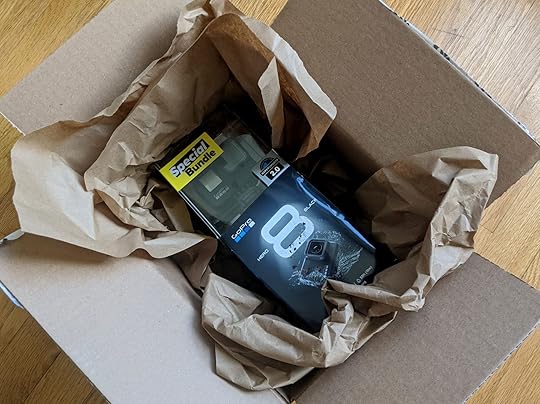 Not unboxing, but re-boxing and returning
Not unboxing, but re-boxing and returningWhy it’s being returned
The most problematic issue with the Hero 8 is its TERRIBLE battery life, which makes it completely impractical for the backcountry. Its performance on my trip was almost unbelievable: I shot just 27 clips totaling 16:56 before the battery died.
We started early on a Saturday, and by mid-morning I noticed that the battery was being depleted rapidly. The camera was “off,” but I speculated that something was running in the background. So I turned off Wi-fi, GPS, voice control, and Boost, and I turned down the screen brightness. That may have helped some, but it wasn’t enough.
The camera burns through the battery when it’s recording and also when it’s not. For example, while sitting on my desk for the past 72 hours, the battery has gone from 62 percent to 47 percent, or a 5 percent daily drain. I’m appalled that GoPro has not solved this issue in the eighth generation of this product. And, no, removing the battery between uses and at night is not an acceptable option.
Online reports of piss poor battery life and battery drain are widespread. While the device specs at 81 minutes of recording (at 1080p/60fps), realistically it’s much less, especially with the battery drain.
Updating the firmware, reformatting the memory chip, and turning off all the nice-to-have features (why bother then?) has not solved the problem.
Another concern
A lesser concern with the Hero 8 is that it does not have a lens protector. If it falls the wrong way onto some rocks, or if it’s simply abraded by Utah sand in a hipbelt pocket, the image quality will never be the same.
Replacements
At this point, I only know one thing: the Hero 8 Black isn’t going to work for me. But I’m not yet certain what I will get instead.
I’m looking at the DJI Osmo Action but I’m not totally sold. It has a replaceable lens cover, but the battery life is only marginally better — 135 minutes at 1080p/30fps with everything turned off.
Two other options:
Buy a gimbal and external mic for my smartphone; or,Shoot more video with my trusted Canon G9X camera, and when necessary take audio through a standalone system run through my smartphone, which can be combined in post-production.
Thoughts and suggestions are welcome.
Disclosure. I strive to offer field-tested and trustworthy information, insights, and advice. I have no financial affiliations with or interests in any brands or products, and I do not publish sponsored content
This website is supported by affiliate marketing, whereby for referral traffic I receive a small commission from select vendors like Amazon or REI, at no cost to the reader.
The post Re-boxing: Why I’m returning the GoPro Hero 8 appeared first on Andrew Skurka.
July 2, 2020
Last call: Register now for Session 3 of our online planning course
Session 3 of our online planning course starts on Monday, July 13, and registration will close on Tuesday, July 7.
To save yourself time and money, and to make the most out of your 2020 and future backpacking trips, register now.
Sessions 1 and 2 both sold out, and Session 3 is about 60 percent of the way there.
During the course, among other things you will learn to:
Research likely environmental and route conditions like the weather, bug pressure, water availability, and problem bears;Select appropriate gear for the conditions and your backpacking style;Plan meals, including dinners that go beyond Ramen noodles or expensive freeze-dried packages;Assemble a navigation system of maps, resources, and tools; and,Acquire requisite skills and fitness for your itinerary.
Our course delivers tremendous value with personal instruction. Joe McConaughy, Hunter Hall, and Brandon Chase will double-check all of your work — they will review your conditions assessment, gear list, chosen overnight food storage method, and map set. It’s like having a backpacking coach.
The cost is $145, and it quickly pays for itself. You will be sent a copy of The Ultimate Hiker’s Gear Guide, and you will receive generous discounts up to 50 percent off from vendors like Gossamer Gear, Mountain Laurel Designs, Sierra Designs, ULA, and Warbonnet Outdoors.
Learn more and register now!
What do former students stay about the course?
Session 1 started in April 27 and concluded on June 24. In a post-course survey, students had this to say:
As a novice backpacker, it can be an overwhelming experience trying to plan for a trip, such as figuring out what gear to buy, what kinds of food and how much to bring, what skills I need to know, and much, much more. Andrew Skurka’s course saved me money and time and made me feel much more confident in my capacity to plan for a trip. — Paul S
The course content is very helpful for backpackers of all skills. The skills I have learned will help me become a more efficient trip planner and allow me to have more successful backpacking trips. — Meredith D
Andrew Skurka’s backpacking planning course was more valuable (and fun) than I ever imagined. I’m an age fifty-plus hiker who has primarily done shorter 1-2 day hikes and more extended camping trips, and this course thoughtfully taught how to plan for longer hikes. The assignments require real thought and effort, but are well supported by readings and resources, and backed up by one-on-one feedback. You will walk away from this course both happier and better prepared. — Jon S
This course provides a pragmatic and structured framework for planning your trips, regardless of the duration. It is flexible enough for a weekend getaway and complete enough for a major thru hike. Well worth the time and money spent to learn from the world-class instructors. — Scott H
As someone new to the sport, this was so valuable! I learned so much and really appreciated the expertise and of the instructors. — Kelly F
It’s is a comprehensive course that guides beginning to experienced backers through the trip planning and preparation process. The student has access to expert backpackers (Joe McConaughy and Hunter Hall) who provide feedback and answer questions. This class is an amazing bargain for the price and like many things in life – you will get out what you put in! — John C
The post Last call: Register now for Session 3 of our online planning course appeared first on Andrew Skurka.
June 23, 2020
Watch & listen: Five podcasts & interviews
Several podcasts and interviews have aired recently:
Out & Back with Gaia GPS
My favorite interviews are those that dive deep on a specific subject matter, because I can share more information and experience than I reasonably could in a blog post. In this episode, we mostly focused on navigation skills and equipment, and it’d be a great supplement to my four-part series on the topic.
Colorado Mountain Club
The CMC has been generating much more online content since it was forced to cancel all in-person classes and events this spring. In late-April over Zoom we hosted a 90-minute trip planning clinic, which was perfectly timed since I was launching my online course at around the same time so the content was fresh. Joe McConaughy (“Stringbean”) joined us to add additional perspective and to help field questions from the audience.
Seek Outside
This Colorado-based company is best known for their premium Made-in-USA lightweight hunting backpacks and shelters, and it recently expanded into the three-season backpacking market with the Flight Series.
This interview included more biographical information than the others because few in the Seek Outside audience probably knew of me already. The most interesting topic in the discussion was “adult onset hunting.”
Broken Laces
Riley Smith launched this hiker-oriented podcast series about a year ago, and has been doing interviews and focus sessions on a broad range of topics.
New Long Trail FKT
Two days after Joe McConaughy (“Stringbean”) set a new unsupported FKT on Vermont’s Long Trail, I interviewed him over Zoom for an hour. Wife Katie and Hunter Hall were also on-hand to add color and field questions from the 300-person live audience.
The post Watch & listen: Five podcasts & interviews appeared first on Andrew Skurka.



